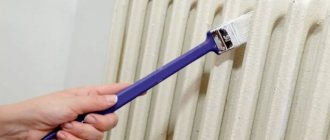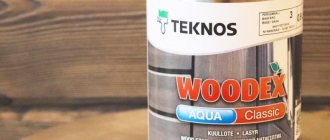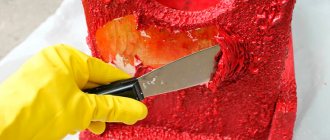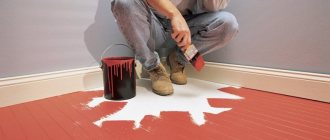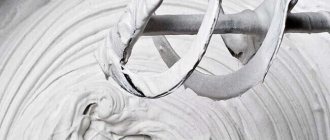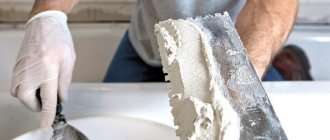Heating radiators in the house require mandatory painting. The best paint for radiators will protect surfaces from adverse external influences and give the room a presentable appearance. From the variety of coating options for pipes and heating radiators, it is better to choose paints and varnishes in accordance with the type of room, operating features, and surrounding design. Basic requirements for paint and varnish materials: durability, reliability of the coating without compromising the integrity of the outer layer during the stated period, resistance to sudden temperature changes, aesthetics, environmental safety without the release of unpleasant odors.
DekArt MA 15
The manufacturer recommends using paint for treating metal heating pipes. Since the palette of shades is wide, the batteries can be painted in any color, taking into account the characteristics of the overall design of the room.
Advantages:
- high surface protection from aggressive influences;
- wide palette of bright colors;
- the ability to give a pleasant appearance to the radiator, adapting to the interior of the room.
One of the downsides is the pronounced smell.
To paint or not
First of all, let's figure out which batteries can be painted and which cannot.
You can - any heating appliances whose warranty period has long expired. Whether this should be done is another matter. For example, modern aluminum and bimetallic heating devices are supplied for sale already painted. The standard color is white, which may not suit homeowners. But it is not recommended to paint them at home, since the applied coating will not last long and will begin to peel off from the surface.
In the factory, these batteries are painted with powder paints using special electrical equipment and drying chambers, in which drying takes place at temperatures up to +300 degrees and above, which is necessary for the polymerization of the coloring composition. It is impossible to create such conditions at home.
There are 3 ways out of this situation:
- order radiators of the desired color from the manufacturer;
- go to a car painting salon that uses the same technology;
- find a company that performs custom powder coating.
Equipment for this technology is very expensive Source vistanews.ru
It is important! It must be remembered that painting heating radiators that are under warranty will automatically void it.
Another type of radiator that should not be painted, regardless of its “age” and appearance, is convector plate devices. Moreover, both old-style wall-mounted and modern, floor-mounted. Painting significantly reduces their heat transfer, so it is better to cover them with decorative panels or grilles.
Wall-mounted plate-type convector radiator Source santechniki.com
All other batteries - cast iron ribbed, steel panel and others - can be painted. But not any composition, but only one that has certain properties.
Sniezka Supermal
Paint has been developed for heating radiators made of cast iron and steel. The product can be used in public areas.
Pros:
- resists atmospheric and mechanical influences;
- low consumption;
- bright shades – 23 colors;
- products comply with all current standards.
No deficiencies were found.
Radiator Festek
This is a one-component, odorless paint for radiators, which guarantees high resistance of the coating to the negative effects of water. After painting, the batteries have a nice matte white color.
Advantages:
- no odor;
- high resistance to moisture and dry abrasion;
- lack of yellowness;
- ability to withstand heat up to 95 degrees;
- quick drying.
The only disadvantage is vulnerability to increased operational loads.
Alkyd enamel
Alkyd enamel for heating radiators is available in a wide range of colors. Although it has a slight odor, it dissipates quickly. In addition, such dyes are characterized by color fastness.
Depending on the basis there are:
- Solvent-based alkyd enamel for radiators . This enamel has a very strong pungent odor, although the surface is beautiful and glossy. The most commonly purchased enamel is PF-115. Sometimes they choose Pesto enamel - its disadvantage is that it requires tinting with blue pigment to avoid yellowing.
- Organosilicon enamel turns out matte . As a rule, this group contains heat-resistant paints with a temperature threshold of up to 600 ℃. Sometimes they produce aerosol paints for heating radiators from this category - they are much easier to apply.
- Water based paint for radiators . These paints vary in their area of application. In particular, heat-resistant types of enamel are used for radiators so that they do not darken over time. In white enamel, titanium pigment is desirable. The main guideline when choosing quality paint is its price.
Remontti Assa Tikkurila
This is a Finnish good paint for batteries, which contains an acrylate binder. At the same time, the manufacturer did not use organic solvents. The products are absolutely safe for people suffering from allergies or asthma.
Advantages:
- the dye is made using innovative technologies and high-quality materials;
- high security;
- resistance to washing and abrasion.
The only downside is the high price of the product.
Video description
See how quickly you can restore a cast iron battery using spray paint:
Another representative of this group is hammer paint. This is the same alkyd enamel on an organic basis, but with the addition of wax, aluminum flakes and other fillers, creating an impressive hammer-chased texture on the surface that hides all irregularities well.
The most popular products of this type are Hammerite primer enamels, which can be applied directly to rust, eliminating pre-priming and anti-corrosion treatment from the technology.
HAMMERITE hammer paint for metal and rust Source images.obi.ru
Balakryl Radet
This high-quality product can be used to paint heating radiators in residential and industrial buildings.
Advantages:
- can be used in rooms where there is high humidity;
- can withstand temperatures of 100 degrees, so the coating on heating radiators does not lose its original appearance for a long time.
There were no deficiencies found in this paint product.
Rules for painting heating appliances
Painting radiators requires special tools. For example, a curved brush, so buy everything you need in advance. The painting process always begins with preparatory activities and only after that the work begins.
Painting cast iron heating radiators.
Preparatory stage
To make painting batteries comfortable, you need to prepare a number of materials and tools in advance. Namely:
- paint;
- 2 brushes – curved and straight;
- primer;
- solvent (except water-dispersion enamel);
- old rags;
- newspapers or polyethylene;
- sanding paper (No. 2);
- protective equipment - rubber gloves, respirator.
If the radiator has already been painted, it must be cleaned of the old coating. Of course, applying from above is acceptable, but this will significantly reduce the level of heat transfer.
After removing the old paint, proceed as follows:
- Sand the surface with an abrasive material to make it smooth.
- Wash with a cloth and detergent.
- Wipe dry - there should be no moisture on the batteries.
- Degrease with solvent - there should not be the slightest grease.
- After drying, treat with a primer.
Tikkurila Empire
If you haven’t decided what paint to paint the batteries with, then you should turn to this development of Finnish specialists. Use a ready-made concentrate and white spirit diluent. After applying the product, the surface becomes semi-matte.
Advantages:
- minimal risk of smudges when painting;
- maximum adhesion to metal surfaces;
- no odor;
- wide palette of shades;
- easy and quick application.
Flaws:
- To apply paint, the room must have an air temperature of 5 degrees and a humidity of 80%;
- careful preparation of the battery is necessary for successful staining;
- high consumption - 12 liters per 1 m2.
Preparatory work
After the choice of paint for the radiator is made in accordance with the requirements for the composition and functional features of the product, you can begin the preparatory stage. It consists of the following actions:
1. First, you should treat the surface of the radiator. Secondary painting is usually done, so it is important to accurately assess the condition of the radiator before treatment. If at least five layers of paint have already been applied to the battery, then it is better to remove excess paint using mechanized cleaning.
2. If the previously applied layers are severely damaged, if the paint is cracked or peeling, it must be completely removed to the very base of the metal. For this purpose, special machines or chemical washes are used. This procedure should be performed especially well.
3. In the case where there are no more than three layers, it is enough to treat the surface with sandpaper. It’s worth choosing fine-grained ones. All drips and drops that formed as a result of preliminary staining are preliminarily cut off. The surface must be smooth, without the slightest roughness.
4. After processing with sandpaper, the surface is treated with chemicals that degrease the surface. This can be done using acetone or solvent. Often such work requires several degrees of processing. Only after this is the enamel applied to the surface.
Sadolin Master 30
This Swedish product is suitable for painting metal batteries. Makes the surface semi-matte with a pleasant shine.
Advantages:
- high protection against corrosion, rot, mold and mildew;
- no smudges during painting;
- high resistance to atmospheric influences;
- abrasion resistance;
- fits perfectly on different surfaces;
- wide choice of shades.
The downside is the faint smell of paint, so you need to ventilate the room after work.
Professional Gloss JOHNSTONE'S
British paint developed for painting metal batteries. It is based on a durable alkyd resin that provides a durable finish.
Advantages:
- perfect coverage;
- pleasant gloss;
- high resistance to negative external influences: shock, temperature.
The disadvantages of the product include the high price.
Brief overview of manufacturers
Heat-resistant paints and varnishes for painting heating systems, both imported and domestic, are available for sale. Both of them are quite suitable for painting batteries in a cottage or apartment.
Among the main manufacturing companies we can mention:
- Scandinavian TIKKURILA with the “Termal” series.
- German DUFA series “Thermo” and “Aqua-Heizkorperlack”.
- Russian TEX with special “enamel for radiators”.
- Polish SNIEZKA .
- Slovenian BELINKA .
- Russian LAKRA .
There are many options with different prices and composition, there is plenty to choose from. Moreover, when choosing a primer for paint, it is best to opt for products from one manufacturer. There is no point in experimenting with mixing what is cheaper.
An overview of popular thermal paints that are used for painting radiators, metal stoves and other elements of the heating circuit is given in this article.
Which paint to choose
When looking at numerous photos of battery paint, you need to pay attention not only to the picture with the result, but also to know the composition and characteristics of the product:
- Oily. This is a budget option, which is presented in a wide range. But after painting, you will have to wait a long time for the dye to dry and endure a strong, unpleasant odor.
- Acrylic. These dyes dry quickly and do not smell, but it is not always possible to get the perfect shade.
- Alkyd. After their application, the coating is not afraid of high temperatures and mechanical factors. But during painting there is an unpleasant odor.
- Heat resistant. An excellent choice for heating radiators, as the coating remains white without yellowing and withstands high temperatures.
If you buy the right paint and take into account all the recommendations for its application, you can update the condition of the radiators, slightly change the overall design of the room and enjoy the result for a long time.
When to dye
A question that worries many: when is it advisable to paint batteries - before or during the heating season. In some regions, the cold season lasts a long time and the heating season takes at least 6 months, so not everyone can wait for the onset of warm weather to update the appearance of the batteries. In this regard, modern manufacturers offer paint that can be applied to warm radiators.
However, if possible, it is better to paint the batteries in the warm season, when the heating is turned off. There are two reasons for this. When painting hot batteries with an acrylic composition, it will dry out instantly, which will not allow for uniform and high-quality painting of the surface.
The second reason is the presence of an unpleasant odor, which is emitted by all compositions when stained. When applied to a hot surface, the strength of the odor increases several times.
In summer, it is possible to provide high-quality ventilation in the room or completely remove the radiator to carry out painting work in the fresh air.
